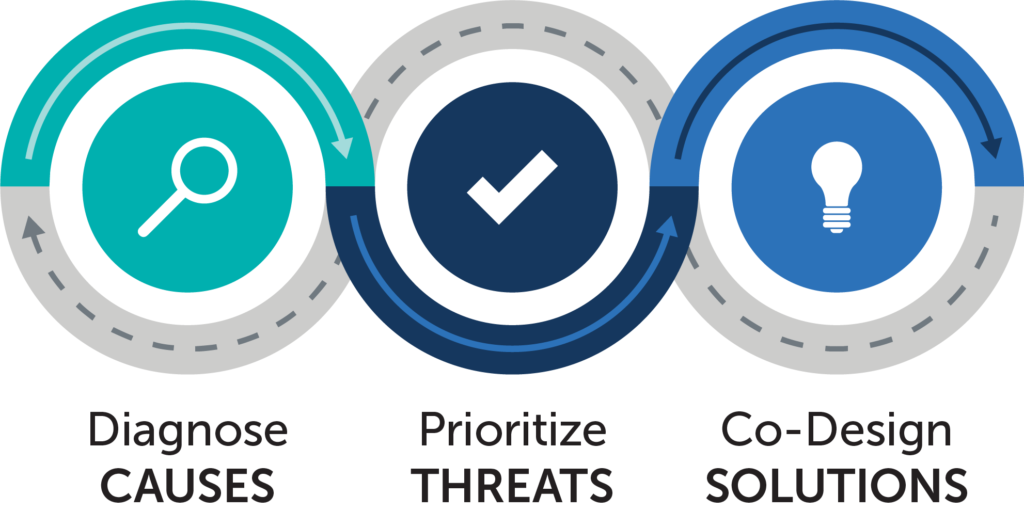Teacher Morale Resource Center for K-12 Districts
-
Diagnose causes
-
Prioritize threats
-
Co-design solutions
Teacher morale is at an all-time low, causing disruptions in pandemic recovery initiatives, teacher absenteeism, and decreased quality in instruction. And districts’ current investments to improve morale—such as expanding wellness programs and increasing teacher appreciation efforts—have not worked.
But low teacher morale—even during challenging times—isn’t inevitable. EAB has uncovered outlier organizations across industries that dramatically improved employee morale despite challenging circumstances. Their success was not defined by a one-size-fits all or predetermined set of ideas for morale. Their success shared one common ingredient: all outlier organizations diagnosed the evolving needs of employees and co-developed and adjusted morale improvement solutions in collaboration with employees. EAB has distilled this process into the teacher morale momentum loop.

EAB’s Teacher Morale Momentum Loop Implementation Guide
Use this step-by-step project planning tool to diagnose the major causes of low teacher morale within a district, determine how to prioritize a district’s biggest threat areas, and co-design sustainable solutions with teachers to ensure lasting results.
1. Diagnose causes
To successfully improve morale, leaders must align their perceptions of teacher morale drivers with teachers’ actual wants and needs. Most districts do not have a strong system in place that diagnoses the why behind low morale nor collects the information frequently enough. The pandemic has made it evident how often teachers’ needs change even over the course of one school year.
Most school districts (80% of district leaders respondents, to EAB’s fall 2021 survey, who measure morale at all) rely on an annual ‘climate survey’ measurement approach. But best practice organizations focus on shorter, more targeted feedback collection at least quarterly. These organizations also embed ways to balance quantitative feedback with qualitative input to dig deeper into the root drivers of morale concerns, so they can better target solutions.

Implementation tools
EAB has designed several supporting resources to help districts complete this step of the morale momentum loop. Districts should use the below resources to collect both quantitative and qualitative information from teachers.
2. Prioritize threats
Once organizations diagnose the reasons behind low morale, too often their next step is to throw several possible remedies at the most common problems that teachers raise. As a result, leaders attempt more than they can realistically address, which undermines trust and does not effectively improve teacher morale.
Instead, school districts must prioritize tackling one or two root-causes of morale at a time based on potential impact on morale and the feasibility for the district to effectively act on that root cause. District and school leaders must also be mindful about consistently communicating feedback results, planned next steps, and rationale to teachers to keep them engaged and active participants in the momentum loop.

Implementation tools
EAB has designed several supporting resources to help districts complete this step of the morale momentum loop. Districts should use the below resources to prioritize morale threats and communicate decisions to teachers and principals.
3. Co-design solutions
The best organizations realize that top-down implementation of morale improvement strategies is usually ineffective. Grassroots efforts and strategies designed by teachers work better. However, most teachers (and leaders alike) do not have the time or bandwidth to come up with their own morale-boosting solutions from scratch.
Districts must find ways to lower the participation barriers to solution development and avoid putting teachers on the hook to figure out how to improve their own morale. Instead, district leaders should offer a menu of ideas that teachers can help refine. Leaders should also integrate time for this into existing structures and incentives.

Implementation tools
EAB has designed several supporting resources to help districts complete this step of the morale momentum loop. Districts should use the below resources to begin workshopping and co-designing solutions specific to their district.
- Guide to Co-Designing Solutions
- Teacher Morale-Booster Compendium
- Planning for Permanence Toolkit: Use this toolkit as a guide for district leaders to restart the process and make the Teacher Morale Momentum Loop a permanent fixture in their district.
This resource requires EAB partnership access to view.
Access the resource center
Learn how you can get access to this resource as well as hands-on support from our experts through District Leadership Forum.
Learn More